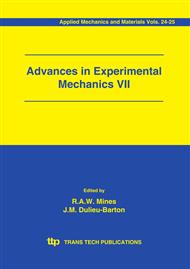p.245
p.253
p.261
p.267
p.275
p.281
p.287
p.299
p.305
Acetabular Component Deformation under Rim Loading Using Digital Image Correlation and Finite Element Methods
Abstract:
Total hip replacement is a highly successful operation; restoring function and reducing pain in arthritis patients. In recent years, thinner resurfacing acetabular cups have been introduced in order to preserve bone stock and reduce the risk of dislocation. However concerns have been raised that deformation of these cups could adversely affect the lubrication regime of the bearing; leading to equatorial and edge contact, possibly causing the implants to jam. This study aims to assess the amount of deformation which occurs due to the tight peripheral fit experienced during press-fit by applying rim loading to three different designs of acetabular cup: a clinically successful cobalt chrome resurfacing cup, a prototype composite resurfacing cup and a clinically successful polyethylene monobloc cup. Digital Image Correlation (DIC) was used to measure the deformation and to validate Finite Element (FE) models. DIC provided a non-contacting method to measure displacement; meaning the load could be increased continuously rather than in steps as in previous studies. The physical testing showed that the cobalt chrome cups were significantly stiffer than the composite prototype and polyethylene cups. The FE models were in good agreement with the experimental results for all three cups and were able to predict the deformation to within 10%. FE models were also created to investigate the effect of cup outside diameter and wall thickness on stiffness under rim loading. Increasing outside diameter resulted in a linear reduction in stiffness for all three materials. Increasing the wall thickness resulted in an exponential increase in cup stiffness. Rim loading an acetabular shell does not accurately simulate the in vivo conditions; however it does provide a simple method for comparing cups made of different materials.
Info:
Periodical:
Pages:
275-280
Citation:
Online since:
June 2010
Authors:
Permissions:
Share:
Citation:


